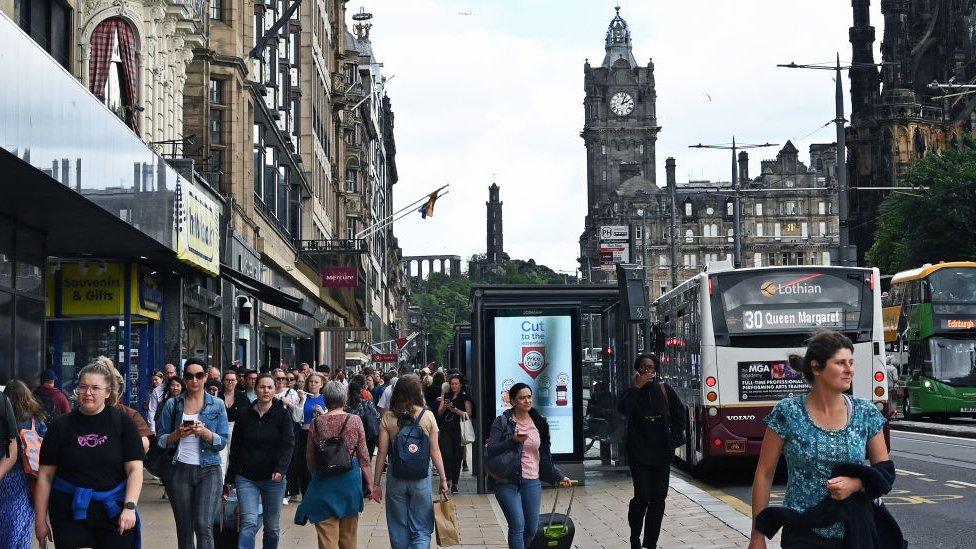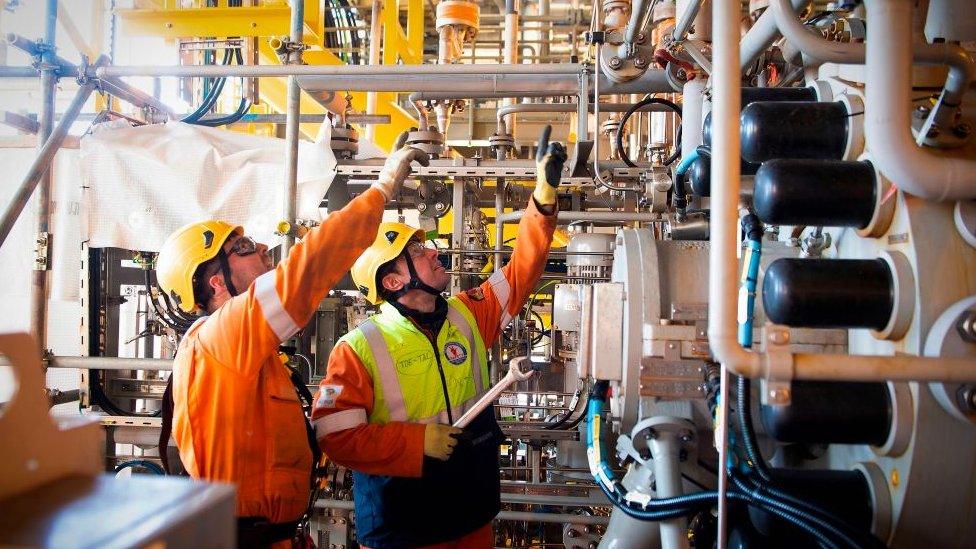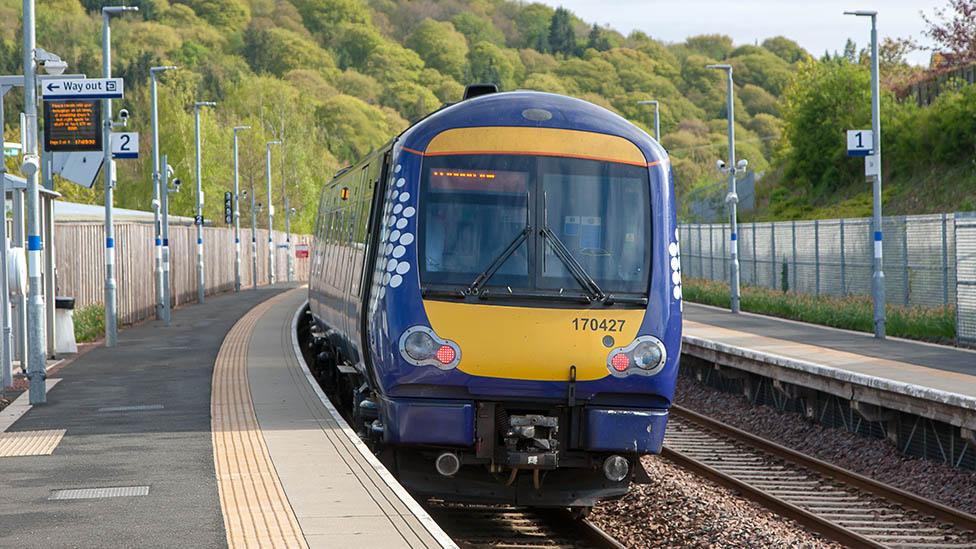Scotland's economic forecast turns dreich
- Published

A new forecast has downgraded economic growth in Scotland this year to a fifth of a percent, as data and business surveys reflect the impact of rising costs and dampened consumer spending.
Company insolvencies during summer were running at 20% higher than pre-pandemic.
Business investment is being delayed or cancelled, but there's optimism to be found, and the jobs market is resilient… probably.
If you're after good news about the Scottish economy, look away now. It's not unrelentingly grim, in that there are underlying strengths there, and opportunities to be seized, and many businesses are getting along just fine.
But momentum is in short supply. It may even be "apathy", according to the director of the Fraser of Allander Institute.
The economists there have just published their regular updated forecast, external, and given Scotland's economy a further downgrade for this year.
The weight of negative findings from business surveys and other data points to growth of only 0.2% this year. That is down on the June figure forecasting 0.5%.
Growth forecasts for next year and the year after have not been downgraded. At 0.7% and 1.2%, they look stronger than this year, but they're a long way short of a healthy recovery.
The good news is that it could have been worse. Nearly a year ago, the Bank of England forecast that we'd be in a prolonged though shallow recession by now, lasting all of this year and well into 2024.
The winter months weren't so bad. The economy weathered the surge in energy prices. It has been the summer that has slowed things up.
The higher cost of borrowing money is one obvious reason. This should hardly come as a surprise. The whole point of the Bank of England raising the cost of borrowing is to choke demand out of the economy, and any inflation that comes with it, in the hope that can be achieved without causing a recession.
It hasn't cut inflation as fast as hoped. Decline has stalled - that is, prices in the year to September rose at the same pace as the year to August, and that was only one notch down on the year to July.
It has been helped downwards by food price inflation coming off a high of more than 19% towards a mere 10% inflation over the year. Some items have actually fallen in price month-on-month, including dairy and eggs.

But the decline in the Consumer Price Index measure of inflation has had the brakes applied by fuel costs going up. This impacts any part of the economy that relies on road and air transport of goods and people. Prices are affected by the global cost of crude oil and a renewed weakening of the pound against the US dollar, in which the black stuff is bought and sold.
The Fraser of Allander economists, at Strathclyde University, explain their gloomy prediction with their recent survey evidence from across Scottish private sector firms.
It shows firms struggling to absorb higher input costs for much longer. Those who don't wish to lose custom or market share have been seeking to manage costs, with a squeeze on profits, but say they can only do so for so long.
Today's report says some are responding with shrinkflation, getting less for the same price, and hospitality firms throwing in extra charges with your bill.
But this evidence suggests something that the Bank of England fears when it looks at the outlook for inflation - pent-up pressures, notably in wage costs, are continuing to push consumer prices up.
Pursue debts
Some firms aren't making it through. Figures published on Wednesday, external point to a rise in the number of company insolvencies in Scotland, up nearly 5% in July to September when compared with the same period last year, at 283 firms. They're down by a small number on the second quarter of this year, but up nearly 20% on pre-pandemic levels.
"The year-on-year rise in corporate insolvencies has been driven by an almost 35% rise in compulsory liquidations," according to Iain Fraser of R3, external, which represents the insolvency trade.
"This increase suggests that, faced with financial challenges of their own, more and more creditors are now increasing their efforts to pursue debts they are owed to meet their own financial obligations.
"Times remain tough for Scottish businesses," he continues. "Inflation is still a big worry for many. Prices are going up, and businesses are struggling to reasonably pass on these extra costs to customers.
"As we head into the colder months and energy bills rise, these increased costs are only set to exacerbate current challenges, particularly for higher risk sectors like hospitality and retail."
Sugar rush
Further evidence from the Allander survey, and another this week from Scottish Chambers of Commerce, external, show Scottish firms are reluctant to invest. Their plans are being delayed or cancelled because of rising interest rates and costs.
Without investment, and without the productivity gains it can provide, it is hard to see where more economic growth will come from.
There are public funds to help them, with the British Business Bank recently adding a big new fund to the efforts of the Scottish National Investment Bank, both trying to identify the areas where their involvement can leverage investment from others.
That sluggish investment has knock-on effects for the public sector. The added pay bill for the Scottish public sector is put at around £1.7bn. Tax revenues and the block grant from Westminster don't look likely to close the resulting gap between spending and revenue.
The Treasury in London and the Scottish government are both preparing to set out tax and spending plans next month and December, and with the cost of servicing debt sharply up in the expectation of sustained high interest rates, the Institute of Fiscal Studies says the UK is in a "horrible fiscal bind, as low growth and high debt interest payments mean no room for manoeuvre.
"The UK economy remains stuck between weak growth on the one hand and the risk of persistently high inflation on the other.
"Fiscal and monetary policy must strike a delicate balance - an ill-timed fiscal loosening, such as an unfunded package of pre-election tax cuts, might give a short-term economic sugar rush, but could prove unsustainable and ultimately mean a protracted recession as interest rates rise even further to bring inflation back under control."
Tax cuts are being pushed by Conservative MPs at Westminster, while tax raises seem a more likely response at Holyrood.

Audit Scotland warns that infrastructure projects are outstripping the funds available, and some will have to be delayed or cancelled
Audit Scotland warns that infrastructure projects are outstripping the funds available, and some will have to be delayed or cancelled. They are also part of the plan to improve productivity and economic performance.
The first minister's new commitment to a council tax freeze has made it even more difficult to make the budgets balance without an income tax raid by Holyrood on higher earners, and that too could be expected to weigh on the economic growth rate.
Tough times
For one of the most recent takes on the private sector in Scotland, the Purchasing Managers Index for September, external identified a contraction in output, the first since January. It is only slight, and not as clear as the figure for the UK as a whole.
Inflow of new work has weakened as well, which is often an indicator of further problems down the line.
But being in business is no place for the terminally gloomy. There are signs of optimism rising in the PMI survey, for Royal Bank of Scotland, in the belief that customer demand will return.
There is also a positive outlook about employment. The weak level of demand is not seeing workers laid off, and many are still struggling to find the skilled staff they want to hire.
This week's job figures for the UK, from the Office for National Statistics, suggest the June-to-August number of those seeking work remained at 4.3% of working age adults. That's higher than it was, but still low by historic standards, and rising much less steeply than you might expect from the less happy data.
How about Scotland's unemployment? There's a problem there. The PMI figures show Scottish recruitment running at a stronger rate than the UK as a whole, much of that in the service sector.
The ONS figure for May-to-July rose quite steeply to match the UK rate. But the official counter of things has not published figures for Scotland, or other nations or regions of the UK. There isn't even a breakdown between male and female. The problem is one of data quality. The Labour Force Survey is failing to reach a representative sample of workers.
Eight years ago, it reached more than 90,000 people across the UK over three months. This year, it was only just over 50,000, with too few home renters and young people responding to ONS questionnaires.
The survey is being re-launched for online responses as well (how modern!), and should be back to health by March. But for the winter ahead, even those who measure tough times are having a tough time.
